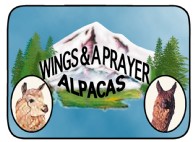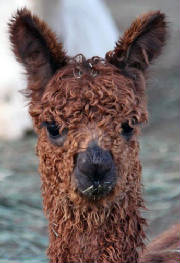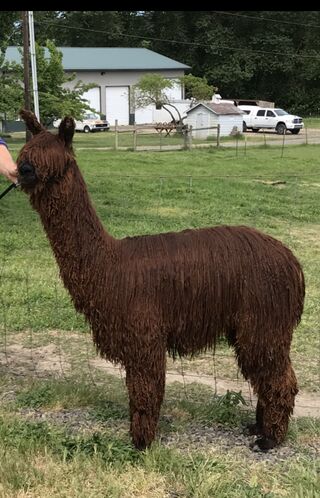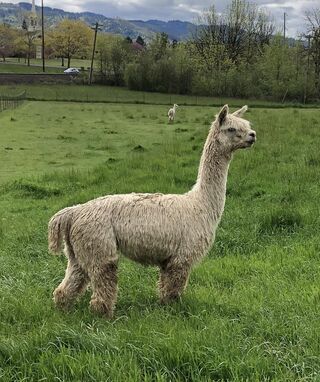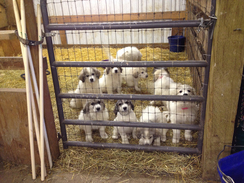Alpaca Facts
ALPACA ORIGINS: Alpacas are native to the Andes Mountains in South America. They are one of four species of South American camelids (which include the llama, vicuna and guanaco). Alpacas are ruminants with three stomach compartments that efficiently convert grass and hay into energy. Their feet are padded which makes them very easy on the ground and friendly to the environment. Alpacas lack upper front teeth and have a fairly short tongue; therefore they delicately trim the pasture without pulling up the roots. Adult alpacas usually weigh between 120 to 180 lbs and stand 30-40 inches at the withers. Life expectancy is 15-20 years, and many females continue to reproduce into their elder years.
ALPACA BREEDS: There are two "types" of alpacas, the huacaya and the suri. They are similar in size and form, but have distinctly different types of fiber. The huacaya's dense fleece grows perpendicular to its body and has crimp (waves) along its length, giving huacayas a soft fluffy, teddy bear look. The suri has straight fiber that hangs vertical from the animal in ringlets or a dreadlock-type formation. The main characteristics of suri fleece are its briliant luster and silky feel.
ALPACA FLEECE/FIBER: Alpaca fiber is considered a very rare luxury fiber that is warmer, softer, stronger and lighter than wool. Alpaca fiber doesn't possess the prickle factor that is most often associated with wool garments. It is prized for its softness, uniform fineness and strength. In fact, alpaca products may be ideal for those allergic to sheep's wool. Alpacas come in a multitude of colors, twenty-two of which are recognized by the alpaca fiber industry. Besides basic black and white, they come in many shades of fawn, brown and gray. Alpacas are shorn annually with an average fleece yielding two to eight pounds, enough to produce multiple garments. Alpaca fiber is very durable and lightweight and is used to produce sweaters, scarves, socks, hats, vests, luxurious coats, slacks, suits, blankets, rugs and more.
CAMELIDS: Although they have many similarities, alpacas and llamas have distinct differences. Alpaca fiber is much finer, softer and denser and alpacas are about half the size of llamas. While llamas tend to have an "in your face" personality, the alpaca is more aloof, similar in nature to a cat. Alpacas have shorter, straighter ears, unlike the "banana" ears of the llama. They are not suitable for packing while the llama is used for packing.
TRANSPORTATION: Alpacas are easy to transport and can be transported in a horse trailer, an SUV, a minivan or a canopied pickup as they typically lie down (cush) while the vehicle is moving. We even took a young male to a farm in the back seat of our (fully-enclosed) jeep once (to the delight of our grandson sitting in the front seat!)
LAND REQUIREMENTS: Alpacas need adequate, well-maintained pastures or pens and should be fenced in. Fencing should be high enough (4' is usually sufficient) and tight enough to keep out all potential predators, including dogs. This is dependant on where you live and what type of predators you may have in your specific area. Alpacas do not, as a general rule, challenge fences - the fences are more to keep other animals and predators out. Alpacas are hardy and adapt to all climates. However, they need protection from temperature extremes. In very warm climates proper ventilation and fans may be utilitzed and even A/C can be used in extreme climate conditions although not recommended. Some of our alpacas enjoy having their chest or bellies sprayed with a hose or sprinkler during hot summer days. Some people even use small children's swimming pools for their alpacas to cool off in.
Alpacas do well on pasture or clean, grass hays. Overfeeding and frequent use of hi-protein hays, such as alfalfa, are unhealthy and should be avoided. Fresh water should always be available along with supplemental mineral mixtures formulated for your specific area of the country. Alpacas tend to create community manure piles, inhibiting the spread of parasites and facilitating pasture clean up. Alpaca "poop" has little odor and makes a perfect fertilizer.
ALPACA BEHAVIORS: Alpacas communicate in a variety of ways. Posturing with the ears, neck, and tail is often used to maintain the pecking order of the herd. They may spit at each other as a warning to back off. Their most common sound is a pleasant, soft humming. Mothers often cluck to their newborn babies. Occasionally one can hear an alpaca alarm call, warning the herd of possible danger. Alpacas are herd animals and prefer the company of other alpacas.
ALPACA CARE/HUSBANDY: Alpacas are hardy, disease resistant animals. Health care is minimal and includes vaccinations to protect against parasites and various diseases of local concern. Periodic worming is also recommended, the frequency dependent on location, weather, pasture tendencies, and herd management decisions. If possible, we like to only worm "as needed" so that we don't develop resistance to worming medications. Their nails are trimmed "as needed" (small, sharp pruning shears work nicely) and not allowed to grow long and curl. Some alpacas need occasional teeth trimming. The fighting teeth of adult males (typically developing at 2+ years of age) are usually cut off at gum level to prevent males from injuring each other when vying for position in the herd.
REPRODUCTION: Female alpacas are generally ready to breed at 15-24 months of age. They are induced ovulators, meaning breeding induces ovulation. Males mature more slowly and typically begin breeding at 2 to 3 years of age. Males and females should be separated at approximately 6-8 months of age (typical time of weaning), as an occasional alpaca can become sexually mature early. The most common method to confirm pregnancy is to place a male in with the female (referred to as behavior testing). If she is not pregnant, she will generally be receptive to breeding. If she is pregnant, she will typically spit at the male. Pregnancy is also confirmed with ultrasound and/or progesterone level testing. The mother (dam) may be rebred three weeks after giving birth. The gestation period for alpacas is approx. 335 days. Females produce a single baby, called a cria. On rare occasions, alpacas give birth to twins. Crias normally weigh from 14-20 lbs.
BREEDER SUPPORT: Alpaca owners enjoy a strong and active national organization, The Alpaca Owners and Breeders Association (AOBA). There are also a growing number of Regional Affiliates and AOBA sanctioned national committees addressing every aspect of the industry. Alpaca owners also enjoy an Alpaca Registry (ARI), which was established to help ensure accurate records with state-of-the-art technology to document bloodlines. In order to be registered, all alpacas must be blood typed. Other organizations that work to benefit alpaca owners are various Fiber Cooperatives, including but not limited to AFCNA and NAAFP. They work to increase awareness of and demand for alpaca fiber and turn member's fiber into quality alpaca garments and products. Members of the Co-ops are able to purchase finished garments and yarn at wholesale prices, thus making it possible for many small farms to generate profits from farm stores.
INVESTMENTS: Alpacas offer a significant return on investment compared to other types of livestock and can offer very attractive tax advantages. If they are actively raised for profit, all the attributable expenses can be written off against your income. Expenses include feed, fertilizer, vet care, travel, farm labor, marketing, depreciation of tangible property and more.
Some investors don't actually raise their animals on a day-to-day basis. Some live in the city and are building their herd toward the day they change careers or retire to country life. Others invest solely for the returns and potential tax advantages provided by alpacas, and therefore board (agist) their animals with alpaca breeders. For all investors, alpacas offer a wonderful way to diversify their investment portfolio with a commodity that is both rare and in demand worldwide.
PRICE RANGE: High-quality breeding females can range in price from about $5,000 to $40,000 and up. Prices vary greatly on males; however, well-known proven herdsires have sold for prices ranging from $50,000 to $1,000,000! Since it is our belief that only the best males should be used as herdsires, pet males may be readily available. Their prices average $200-$1,500 depending on quality of fleece, etc. (about the same as a high quality purebred dog) and many of them are excellent fiber quality animals for those interested solely in the fiber end of the business.
One of the primary reasons people breed alpacas is because they are beautiful and enjoyable to own. Just being able to look out our windows and watch these graceful creatures grazing in our pasture is irresistible, not to mention the strong potential for return on your investment and the tremendous tax benefits they offer. And if that isn't enough? Alpacas are easy to care for, require little maintenance or vet care, and are gentle enough to involve children of any age in all areas of their care. The demand for alpacas in the U.S. is ever increasing and shows no signs of slowing down. There's just something about these creatures that begs you to have one, two, or possibly a whole herd! And of course, there's nothing like watching your alpacas give birth and within an hour having an adorable baby (cria) flitting (and falling!) all over the pasture.
Alpacas tend to be very healthy and easy to look after. They have a gentle nature, which makes them ideal for people who aren't already comfortable with livestock. They don't bite (only have bottom teeth) or butt (no horns). Their only defenses are running and spitting (usually reserved for other alpacas!) Because of their gentle disposition and small stature, children often train and show them. The more accustomed alpacas become to your touch, the gentler they often become. And you don't have to have a big farm or large acreage to raise them. 8-10 can be raised on an acre of land. Although many farms have 100 + animals, the average herd size is 10 with the majority of farms in the US having 5-10 animals.
Tuesday, March 2, 2021
